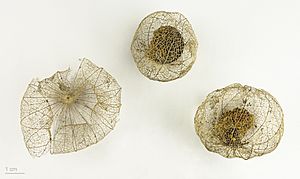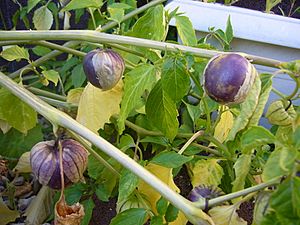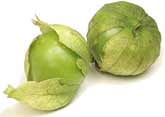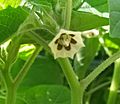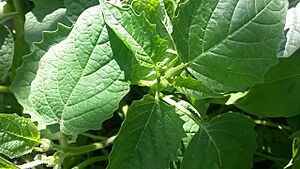Tomatillo facts for kids
Quick facts for kids Tomatillo |
|
|---|---|
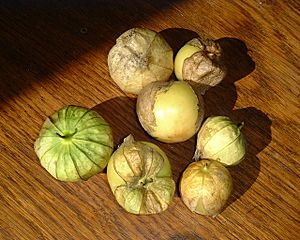 |
|
| Tomatillos | |
| Scientific classification | |
| Genus: |
Physalis
|
| Species: |
philadelphica
|
| Synonyms | |
|
Physalis ixocarpa Brot. |
|
The tomatillo (which means "little tomato" in Spanish) is a plant from the nightshade family. It grows small, round fruits that are usually green or green-purple. Tomatillos are also called the Mexican husk tomato because they come from Mexico. People there have grown them for a very long time, even before Europeans arrived. Tomatillos are a key part of Mexican cuisine, often used raw or cooked in dishes like salsa verde.
Contents
History of Tomatillos
Wild tomatillos and their relatives can be found all over the Americas. They are most common in Mexico. In 2017, scientists found a fossil of a tomatillo in Argentina. This fossil was 52 million years old! This discovery showed that the nightshade plant family, which includes tomatillos, is much older than we thought.
People in Mexico started growing tomatillos long before Europeans came. Tomatillos were very important to the Maya and Aztec people. They were even more important than tomatoes back then! The scientific name philadelphica was given to the plant in the 1700s.
What Are Tomatillos Called?
The word "tomatillo" comes from the Nahuatl language, where it was called tomatl. People also call tomatillos by other names like husk tomato, Mexican groundcherry, or Mexican husk tomato. But be careful, some of these names can also refer to other plants in the Physalis family. Other names include Mexican green tomato and miltomate.
In Spanish, tomatillos have many names. Some common ones are tomate de cáscara (husk tomato), tomate verde (green tomato), or simply tomatillo (in Mexico). In other places, "tomatillo" might mean a small tomato.
The scientific name for the tomatillo's group, Physalis, comes from an old Greek word meaning "bladder" or "to puff up." This might be because of the papery husk that surrounds the fruit.
Where Do Tomatillos Grow?
Tomatillos originally come from Central America and Mexico. Today, they are mostly grown in certain Mexican states like Hidalgo and Morelos. They also grow in the highlands of Guatemala, where they are called miltomate.
In the United States, people have been growing tomatillos since 1863. They were also sent to places like the Bahamas, Puerto Rico, Jamaica, and Florida. By the mid-1900s, tomatillos were being grown in India, Australia, South Africa, and Kenya.
How Are Tomatillos Grown?
We don't have a lot of information about how many tomatillos are grown worldwide. However, they are a popular garden plant. Tomatillos are mainly grown on large farms in Mexico and Guatemala. Smaller amounts are grown in many parts of the United States. In Mexico, tomatillos can be planted at many different heights above sea level.
Soil and Climate Needs
Tomatillo plants can grow in many different types of soil. But they grow best in soil that drains well, is sandy, and has lots of nutrients. The soil should have a pH between 5.5 and 7.3.
Tomatillo plants don't like cold weather. They grow best when the temperature is between 25 and 32 degrees Celsius (77 to 90 degrees Fahrenheit). If it's colder than 16 degrees Celsius (61 degrees Fahrenheit), they won't grow well. Tomatillos also need lots of sunshine and warm places to thrive.
Planting Tomatillo Seeds
Most people plant tomatillos by first growing small plants (called transplants) in greenhouses or special beds. The seeds sprout best when the temperature is between 20 and 27 degrees Celsius (68 to 81 degrees Fahrenheit).
These small plants are then moved outside about 6 to 8 weeks after the seeds were planted. This is done when there's no longer a risk of frost. If the transplants were grown indoors, they need a few days to get used to the warmer, sunnier outdoor conditions before being planted. You can plant seeds directly outside only if there's no frost and the soil is warmer than 15 degrees Celsius (59 degrees Fahrenheit).
Tomatillo plants grow wide and branch out, so each plant needs enough space. They are usually planted in rows that are 0.7 to 1.6 meters (about 2 to 5 feet) apart. Even though tomatillos are perennial plants (meaning they can live for many years), it's hard for them to survive winter in most places. So, they are usually grown as if they are annual plants (meaning they live for only one growing season).
Caring for Tomatillo Plants
Tomatillo plants can grow quite tall, up to 1.5 to 2 meters (about 5 to 6.5 feet). Because they grow quickly and branch out a lot, it's a good idea to support them with stakes. Staking also makes it easier to pick the fruit later. It stops the fruit from touching the ground, which can prevent damage and diseases.
It's good to give tomatillo plants a moderate amount of fertilizer. For example, adding 40 to 90 kilograms per hectare (about 35 to 80 pounds per acre) of phosphorus is common. Other nutrients might be needed depending on the soil and how much water the plants get.
Even though older tomatillo plants can handle dry spells better, they still need regular watering. Tomatillo plants need about 25–38 millimeters (1 to 1.5 inches) of water each week. This water can come from rain or from irrigation systems like drip lines or sprinklers. How often you water depends on the weather and how much the plant has grown. During hot weather, they might need water every day.
Weeds can be a big problem when growing tomatillos, especially in the first few weeks. Using plastic or organic mulches (a layer of material on the soil) can help control weeds. Plastic mulches also help keep water in the soil and can change the temperature around the plants, which helps them grow better.
Harvesting Tomatillos
Tomatillos are ready to pick when the fruit fills its papery husk. This usually happens 65 to 100 days after the plants are moved outside. The plants will keep producing fruit for 1 to 2 months, or until the first frost.
Harvesting is done regularly, often every day, by hand. A single plant can produce between 60 and 200 fruits in one growing season. On average, you can get about 9 tons of tomatillos per acre. Once picked, tomatillos can be stored for up to three weeks in a cold and humid place.
How to Use Tomatillos
Tomatillos are a main ingredient in fresh and cooked Mexican and Central-American green sauces. Their green color and slightly sour taste are what they bring to dishes. Purple and red tomatillos are often a little sweeter than the green and yellow ones. These sweeter varieties are sometimes used to make jams and preserves.
Like their relatives, Cape gooseberries, tomatillos have a lot of pectin. Pectin is a natural substance that helps jams and jellies set. Another interesting thing about tomatillos is that they often have a slightly sticky coating, especially when they are green and just out of their husk.
Ripe tomatillos can be kept in the refrigerator for about two weeks. If you remove the husks and put the fruit in sealed plastic bags in the fridge, they will last even longer. You can also freeze them whole or sliced.
Tomatillos as Food
You can pick tomatillos at different stages of their growth. For salsa verde, they are picked early when they are sour and have a light flavor. If you want a sweeter taste, you can pick them later when they have more seeds. At this stage, they can even be used instead of tomatoes.
Tomatillos can be used in many different ways: in stews, soups, salads, curries, stir-fries, baked dishes, with meats, in marmalade, and even in desserts.
You can also dry tomatillos to make them sweeter, similar to dried cranberries. They will have a hint of tomato flavor. Tomatillo flavor is also used in "fusion cuisine." This is when chefs mix flavors from Latin American dishes with those from Europe and North America.
Tomatillo Plant Details
What the Plant Looks Like
P. philadelphica plants usually grow to be about 15 to 60 centimeters (6 to 24 inches) tall. They have only a few hairs on their stems. Their leaves have sharp, uneven dents on the sides. The plants are typically about one meter (3 feet) tall. They can either grow straight up and be compact, or they can spread out more. The leaves usually have jagged edges and can be smooth or slightly hairy.
Tomatillo Flowers
Tomatillo flowers come in several colors, including white, light green, bright yellow, and sometimes purple. Some flowers might have purple spots in the middle. The parts of the flower that hold pollen (called anthers) are usually dark purple to pale blue.
Tomatillo plants are very "self-incompatible." This means that a single plant usually cannot pollinate itself to make fruit. You need two or more tomatillo plants growing near each other for them to produce fruit properly. So, if you have only one tomatillo plant, it probably won't grow any fruit.
The Tomatillo Fruit
The tomatillo fruit is covered by a papery, inedible husk. This husk forms from a part of the flower called the calyx. As the fruit grows, it fills the husk. By the time it's ready to pick, the fruit might even split the husk open. The husk turns brown as the fruit ripens. The fruit itself can be yellow, green, or even purple when ripe. A fresh, green husk is a sign of a good quality tomatillo.
Flower types:
Different Kinds of Tomatillos
There are several types, or "varieties," of tomatillos. They have different tastes, features, and ripen to different colors. Some common varieties include Amarylla, Gigante, Green Husk, Mexican, Pineapple, Purple de Milpa, Rio Grande Verde, and Yellow.
Tomatillo Diseases
Tomatillo plants are generally strong and don't get sick easily, as long as they have the right climate. However, when many plants are grown together, they can be exposed to pests and diseases. As of 2017, two main diseases have been found to affect tomatillos: the tomato yellow leaf curl virus and the turnip mosaic virus.
In 2006, symptoms of tomato yellow leaf curl virus were found in tomatillo plants in Mexico and Guatemala. These symptoms included yellow edges and yellowing between the veins of the leaves. After testing, the virus was confirmed. Plants with the virus often had whiteflies nearby, which likely spread the disease.
The turnip mosaic virus was found in tomatillo crops in California in 2011. This virus made about 2% of the commercially grown tomatillo plants unsellable. The plants became very small and their leaves were twisted. The green peach aphid is a common pest in California. Since these aphids can easily spread the turnip mosaic virus, it could be a threat to tomatillo farming there.
See also
 In Spanish: Miltomate o tomatillo para niños
In Spanish: Miltomate o tomatillo para niños


